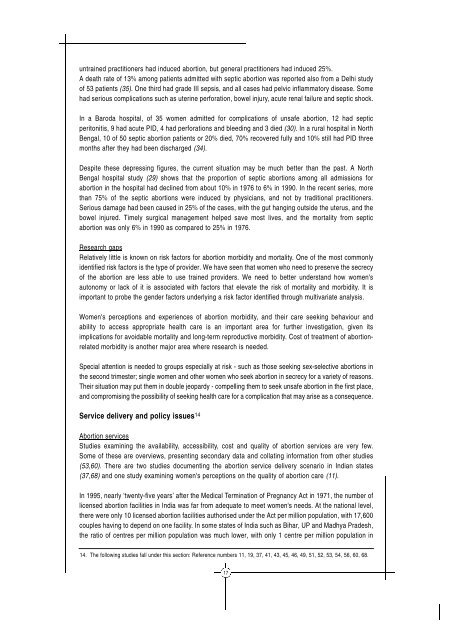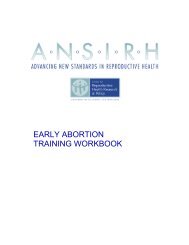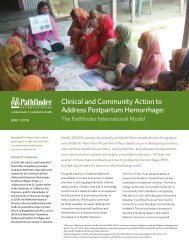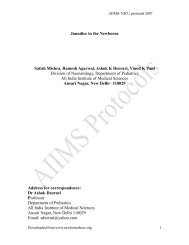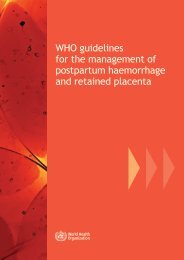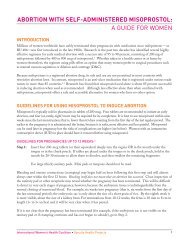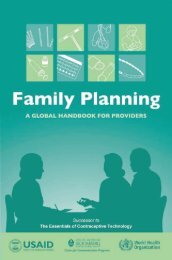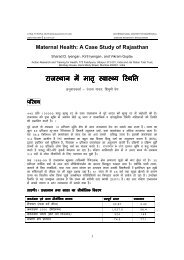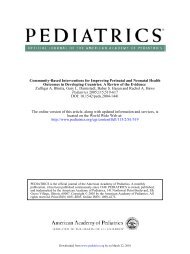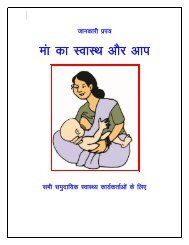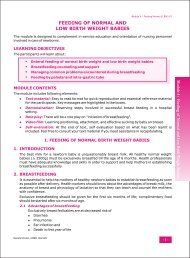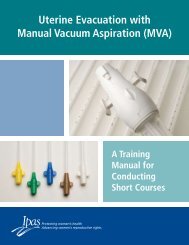Gender Gaps in Research on Abortion in India - CommonHealth
Gender Gaps in Research on Abortion in India - CommonHealth
Gender Gaps in Research on Abortion in India - CommonHealth
Create successful ePaper yourself
Turn your PDF publications into a flip-book with our unique Google optimized e-Paper software.
untra<str<strong>on</strong>g>in</str<strong>on</strong>g>ed practiti<strong>on</strong>ers had <str<strong>on</strong>g>in</str<strong>on</strong>g>duced aborti<strong>on</strong>, but general practiti<strong>on</strong>ers had <str<strong>on</strong>g>in</str<strong>on</strong>g>duced 25%.<br />
A death rate of 13% am<strong>on</strong>g patients admitted with septic aborti<strong>on</strong> was reported also from a Delhi study<br />
of 53 patients (35). One third had grade III sepsis, and all cases had pelvic <str<strong>on</strong>g>in</str<strong>on</strong>g>flammatory disease. Some<br />
had serious complicati<strong>on</strong>s such as uter<str<strong>on</strong>g>in</str<strong>on</strong>g>e perforati<strong>on</strong>, bowel <str<strong>on</strong>g>in</str<strong>on</strong>g>jury, acute renal failure and septic shock.<br />
In a Baroda hospital, of 35 women admitted for complicati<strong>on</strong>s of unsafe aborti<strong>on</strong>, 12 had septic<br />
perit<strong>on</strong>itis, 9 had acute PID, 4 had perforati<strong>on</strong>s and bleed<str<strong>on</strong>g>in</str<strong>on</strong>g>g and 3 died (30). In a rural hospital <str<strong>on</strong>g>in</str<strong>on</strong>g> North<br />
Bengal, 10 of 50 septic aborti<strong>on</strong> patients or 20% died, 70% recovered fully and 10% still had PID three<br />
m<strong>on</strong>ths after they had been discharged (34).<br />
Despite these depress<str<strong>on</strong>g>in</str<strong>on</strong>g>g figures, the current situati<strong>on</strong> may be much better than the past. A North<br />
Bengal hospital study (29) shows that the proporti<strong>on</strong> of septic aborti<strong>on</strong>s am<strong>on</strong>g all admissi<strong>on</strong>s for<br />
aborti<strong>on</strong> <str<strong>on</strong>g>in</str<strong>on</strong>g> the hospital had decl<str<strong>on</strong>g>in</str<strong>on</strong>g>ed from about 10% <str<strong>on</strong>g>in</str<strong>on</strong>g> 1976 to 6% <str<strong>on</strong>g>in</str<strong>on</strong>g> 1990. In the recent series, more<br />
than 75% of the septic aborti<strong>on</strong>s were <str<strong>on</strong>g>in</str<strong>on</strong>g>duced by physicians, and not by traditi<strong>on</strong>al practiti<strong>on</strong>ers.<br />
Serious damage had been caused <str<strong>on</strong>g>in</str<strong>on</strong>g> 25% of the cases, with the gut hang<str<strong>on</strong>g>in</str<strong>on</strong>g>g outside the uterus, and the<br />
bowel <str<strong>on</strong>g>in</str<strong>on</strong>g>jured. Timely surgical management helped save most lives, and the mortality from septic<br />
aborti<strong>on</strong> was <strong>on</strong>ly 6% <str<strong>on</strong>g>in</str<strong>on</strong>g> 1990 as compared to 25% <str<strong>on</strong>g>in</str<strong>on</strong>g> 1976.<br />
<str<strong>on</strong>g>Research</str<strong>on</strong>g> gaps<br />
Relatively little is known <strong>on</strong> risk factors for aborti<strong>on</strong> morbidity and mortality. One of the most comm<strong>on</strong>ly<br />
identified risk factors is the type of provider. We have seen that women who need to preserve the secrecy<br />
of the aborti<strong>on</strong> are less able to use tra<str<strong>on</strong>g>in</str<strong>on</strong>g>ed providers. We need to better understand how women's<br />
aut<strong>on</strong>omy or lack of it is associated with factors that elevate the risk of mortality and morbidity. It is<br />
important to probe the gender factors underly<str<strong>on</strong>g>in</str<strong>on</strong>g>g a risk factor identified through multivariate analysis.<br />
Women's percepti<strong>on</strong>s and experiences of aborti<strong>on</strong> morbidity, and their care seek<str<strong>on</strong>g>in</str<strong>on</strong>g>g behaviour and<br />
ability to access appropriate health care is an important area for further <str<strong>on</strong>g>in</str<strong>on</strong>g>vestigati<strong>on</strong>, given its<br />
implicati<strong>on</strong>s for avoidable mortality and l<strong>on</strong>g-term reproductive morbidity. Cost of treatment of aborti<strong>on</strong>related<br />
morbidity is another major area where research is needed.<br />
Special attenti<strong>on</strong> is needed to groups especially at risk - such as those seek<str<strong>on</strong>g>in</str<strong>on</strong>g>g sex-selective aborti<strong>on</strong>s <str<strong>on</strong>g>in</str<strong>on</strong>g><br />
the sec<strong>on</strong>d trimester; s<str<strong>on</strong>g>in</str<strong>on</strong>g>gle women and other women who seek aborti<strong>on</strong> <str<strong>on</strong>g>in</str<strong>on</strong>g> secrecy for a variety of reas<strong>on</strong>s.<br />
Their situati<strong>on</strong> may put them <str<strong>on</strong>g>in</str<strong>on</strong>g> double jeopardy - compell<str<strong>on</strong>g>in</str<strong>on</strong>g>g them to seek unsafe aborti<strong>on</strong> <str<strong>on</strong>g>in</str<strong>on</strong>g> the first place,<br />
and compromis<str<strong>on</strong>g>in</str<strong>on</strong>g>g the possibility of seek<str<strong>on</strong>g>in</str<strong>on</strong>g>g health care for a complicati<strong>on</strong> that may arise as a c<strong>on</strong>sequence.<br />
Service delivery and policy issues 14<br />
Aborti<strong>on</strong> services<br />
Studies exam<str<strong>on</strong>g>in</str<strong>on</strong>g><str<strong>on</strong>g>in</str<strong>on</strong>g>g the availability, accessibility, cost and quality of aborti<strong>on</strong> services are very few.<br />
Some of these are overviews, present<str<strong>on</strong>g>in</str<strong>on</strong>g>g sec<strong>on</strong>dary data and collat<str<strong>on</strong>g>in</str<strong>on</strong>g>g <str<strong>on</strong>g>in</str<strong>on</strong>g>formati<strong>on</strong> from other studies<br />
(53,60). There are two studies document<str<strong>on</strong>g>in</str<strong>on</strong>g>g the aborti<strong>on</strong> service delivery scenario <str<strong>on</strong>g>in</str<strong>on</strong>g> <strong>India</strong>n states<br />
(37,68) and <strong>on</strong>e study exam<str<strong>on</strong>g>in</str<strong>on</strong>g><str<strong>on</strong>g>in</str<strong>on</strong>g>g women's percepti<strong>on</strong>s <strong>on</strong> the quality of aborti<strong>on</strong> care (11).<br />
In 1995, nearly ‘twenty-five years’ after the Medical Term<str<strong>on</strong>g>in</str<strong>on</strong>g>ati<strong>on</strong> of Pregnancy Act <str<strong>on</strong>g>in</str<strong>on</strong>g> 1971, the number of<br />
licensed aborti<strong>on</strong> facilities <str<strong>on</strong>g>in</str<strong>on</strong>g> <strong>India</strong> was far from adequate to meet women's needs. At the nati<strong>on</strong>al level,<br />
there were <strong>on</strong>ly 10 licensed aborti<strong>on</strong> facilities authorised under the Act per milli<strong>on</strong> populati<strong>on</strong>, with 17,600<br />
couples hav<str<strong>on</strong>g>in</str<strong>on</strong>g>g to depend <strong>on</strong> <strong>on</strong>e facility. In some states of <strong>India</strong> such as Bihar, UP and Madhya Pradesh,<br />
the ratio of centres per milli<strong>on</strong> populati<strong>on</strong> was much lower, with <strong>on</strong>ly 1 centre per milli<strong>on</strong> populati<strong>on</strong> <str<strong>on</strong>g>in</str<strong>on</strong>g><br />
14. The follow<str<strong>on</strong>g>in</str<strong>on</strong>g>g studies fall under this secti<strong>on</strong>: Reference numbers 11, 19, 37, 41, 43, 45, 46, 49, 51, 52, 53, 54, 56, 60, 68.<br />
17


